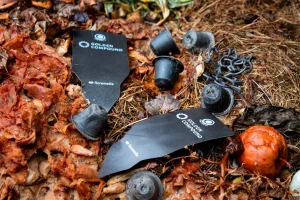With GC green, we offer a unique biocomposite material made from renewable raw materials, including sunflower seed shells. The material combines sustainability with excellent processing properties and opens up a wide range of applications, from injection moulding and thermoforming to technical applications. To ensure that your production runs smoothly and you achieve the best results, we have compiled the most important processing instructions for you.
Our processing instructions for the optimal process
1. Proper storage and drying are crucial
GC green is usually supplied in 25 kg sacks or big bags and is ready for immediate use. To prevent moisture absorption and condensation, the containers should be kept closed and stored in a dry place until shortly before processing. Never store the materials outdoors without protection.
Although the material is ready for processing, we recommend drying it before processing. The exact drying conditions and recommended residual moisture content can be found in the respective material data sheet.
2. Optimal temperatures for the injection moulding process
GC green is specially optimised for injection moulding applications and can be processed with both cold and hot runner moulds. The flowability of the compounds is adjusted to ensure good melting even at low processing temperatures.
- Funnel: 50°C
- Zone 1: 150°C
- Zone 2: 150°C
- Zone 3: 160°C
- Zone 4: 170°C
- Nozzle: 170°C
The hot runner temperature should be between 120°C and 170°C. It is important not to feed the material into the machine until these temperatures have been reached. Otherwise, the material may burn, odours may develop and the surface of the finished article may be poor.
3. The right tools and machine settings
We recommend using standard screws.
Mixing screws can lead to excessive energy input and negatively affect product properties, which is why the mass temperature must be closely monitored when using them.
We advise against using barrier screws, as they exert increased shear force on the material.
Due to the reduced processing temperature and the filler, increased injection pressures may occur during injection moulding. This can be compensated for by reducing the injection speed. If the melt is insufficiently melted, you can increase the dosing speed and back pressure or adjust the screw speed to utilise the frictional heat.
4. Lowering process temperatures and tool temperatures
If the process allows (the article fills well and the injection pressure is correct), the cylinder temperatures can be gradually reduced. This can be done in 10°C increments to reduce the cooling time. The hot runner temperature should be between 120°C and 170°C.
Tool temperatures may vary depending on the desired result.:
- 15–20°C: for fast cycle times
- 20–40°C: for thin-walled items or improved surface finish
- 40-60°C: for thin-walled items with long flow paths or compounds with over 45% shell content to achieve good surfaces
By following these instructions, you can exploit the full potential of our GC green material and manufacture high-quality, sustainable products.
You can find the processing instructions for printing here:



